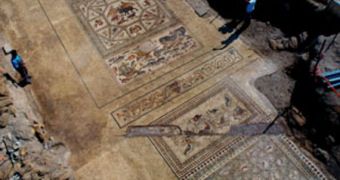Workers with the Israel Antiquities Authority (IAA) have recently discovered an amazingly well-preserved footprint under the Lod mosaic, one of the largest and best preserved ones in the country. The impression left in the background shows the shape of the foot and also the tracks left behind by what appears to be a sandal. Israeli authorities are very excited about the new find, which was made as they were attempting to lift the mosaic from the ground, the Israel Ministry of Foreign Affairs reports.
“It's exciting. This is the first time I have ever encountered personal evidence such as this under a mosaic,” Israel Antiquities Authority Art Conservation Branch Head Jacques Neguer said. He explained that the mosaic was being lifted from the ground in order to be moved to the IAA conservation laboratories, near Jerusalem. Moving such an item is extremely complex, and the experts only handled one piece of the ancient floor at a time.
The mosaic in the city of Lod was found in 1996, but was covered again shortly after, as the funds to handle such a find were insufficient. Just recently, thanks to a donation from the Leon Levy Foundation, this issue could be fixed, and archaeologists could begin the cumbersome job of moving it. The structure is about 180 square meters in size and features carpets depicting scenes including mammals, birds, fish, and floral species in amazing detail. Sailing and merchant vessels in use around 300 CE also appear in the wonderful work of art.
Experts believe that the work adorned the floors of a villa, belonging to a man that prospered in the Roman period. It would now appear that, as the workers laid down the plaster used to keep the mosaic to the ground, they carelessly walked on it, leaving both sandal prints and footprints on the wet mix, which then solidified, and got preserved to this day. “When removing a section of mosaic it is customary to clean its bedding, and that way study the material from which it is made and the construction stages,” Neguer explained.
“We look for drawings and sketches that the artists made in the plaster and marked where each of the tesserae will be placed. This is also what happened with the Lod mosaic: beneath a piece on which vine leaves are depicted, we discovered that the mosaic's builders incised lines that indicate where the tesserae should be set, and afterwards, while cleaning the layer, we found the imprints of feet and sandals: sizes 34, 37, 42 and 44. At least one imprint of a sole resembles a modern sandal. Based on the concentration of foot and sandal prints it seems that the group of builders tamped the mortar in place with their feet,” he concluded.

 14 DAY TRIAL //
14 DAY TRIAL //